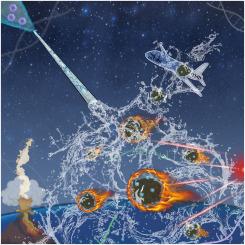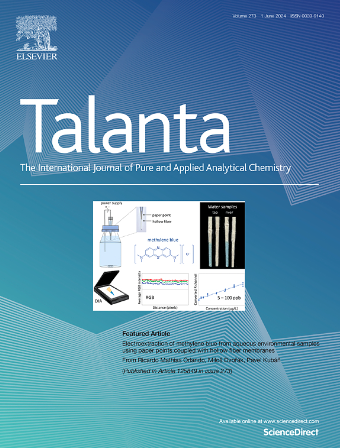靶向驱动的功能化DNA水凝胶毛细管传感器用于SARS-CoV-2双模检测。
IF 6.1
1区 化学
Q1 CHEMISTRY, ANALYTICAL
引用次数: 0
摘要
由严重急性呼吸综合征冠状病毒2型(SARS-CoV-2)引起的冠状病毒病已引起二次大流行,仍对人体健康和经济发展构成严重威胁。本文基于级联信号放大和普鲁士蓝和铂纳米粒子(MnCo@C-Pt-PB NPs)修饰的碳包覆钴锰,成功研制了靶向驱动的功能化DNA水凝胶毛细管传感器,用于SARS-CoV-2的双模检测。靶RNA触发的级联信号扩增导致毛细管中负载的DNA水凝胶的渗透性被破坏,从而在毛细管作用的驱动下,将嵌入的MnCo@C-Pt-PB NPs作为信号分子释放到3,3',5,5'-四甲基联苯胺/过氧化氢(TMB/H2O2)溶液中。随后,由于MnCo@C-Pt-PB NPs类过氧化物酶活性,将无色TMB催化为蓝色氧化产物(oxTMB),在近红外照射下,具有光热性质的MnCo@C-Pt-PB NPs和oxTMB协同提高体系温度,通过便携式设备记录,实现双模检测。在较宽的检测范围内(100 aM-100 pM),信号强度与T-RNA浓度的对数成正比,检测限为100 aM。此外,该方法在口咽拭子样本中的可靠性也得到了验证。功能化DNA水凝胶的信号转换和扩增功能增强了该方法的方便性、灵敏度和通用性,在环境安全、分子诊断和疾病预防等方面具有广阔的应用前景。本文章由计算机程序翻译,如有差异,请以英文原文为准。

Target-driven functionalized DNA hydrogel capillary sensor for SARS-CoV-2 dual-mode detection
Coronavirus disease caused by severe acute respiratory syndrome coronavirus 2 (SARS-CoV-2) has caused secondary pandemic, which still poses a serious threat to physical health and economic development. Herein, the target-driven functionalized DNA hydrogel capillary sensor based on cascade signal amplification and carbon coated cobalt manganese modified by prussian blue and platinum nanoparticles (MnCo@C-Pt-PB NPs) has been successfully developed for dual-mode detection of SARS-CoV-2. The cascade signal amplification triggered by target RNA causes the permeability of the DNA hydrogel loaded in the capillary to be destroyed, thereby releasing the embedded MnCo@C-Pt-PB NPs as signal molecules into 3,3′,5,5′-tetramethylbenzidine/hydrogen peroxide (TMB/H2O2) solution under the driving of capillarity. The colorless TMB is then catalyzed to blue oxidation products (oxTMB) due to peroxidase-like activity of MnCo@C-Pt-PB NPs, and MnCo@C-Pt-PB NPs and oxTMB with photothermal properties synergistically increase the system temperature under near-infrared irradiation, which are recorded by portable devices to achieve dual-mode detection. Signals intensity are proportional to the logarithm of T-RNA concentration in a wide detection range (100 aM-100 pM), with a detection limit of 100 aM. Moreover, the reliability of the developed method in oropharyngeal swabs samples has also been validated. The signal conversion and amplification function of functionalized DNA hydrogel enhances the convenience, sensitivity and versatility of the developed method, which is promising to be applied in environmental safety, molecular diagnostic assays and disease prevention.
求助全文
通过发布文献求助,成功后即可免费获取论文全文。
去求助
来源期刊

Talanta
化学-分析化学
CiteScore
12.30
自引率
4.90%
发文量
861
审稿时长
29 days
期刊介绍:
Talanta provides a forum for the publication of original research papers, short communications, and critical reviews in all branches of pure and applied analytical chemistry. Papers are evaluated based on established guidelines, including the fundamental nature of the study, scientific novelty, substantial improvement or advantage over existing technology or methods, and demonstrated analytical applicability. Original research papers on fundamental studies, and on novel sensor and instrumentation developments, are encouraged. Novel or improved applications in areas such as clinical and biological chemistry, environmental analysis, geochemistry, materials science and engineering, and analytical platforms for omics development are welcome.
Analytical performance of methods should be determined, including interference and matrix effects, and methods should be validated by comparison with a standard method, or analysis of a certified reference material. Simple spiking recoveries may not be sufficient. The developed method should especially comprise information on selectivity, sensitivity, detection limits, accuracy, and reliability. However, applying official validation or robustness studies to a routine method or technique does not necessarily constitute novelty. Proper statistical treatment of the data should be provided. Relevant literature should be cited, including related publications by the authors, and authors should discuss how their proposed methodology compares with previously reported methods.
 求助内容:
求助内容: 应助结果提醒方式:
应助结果提醒方式:


